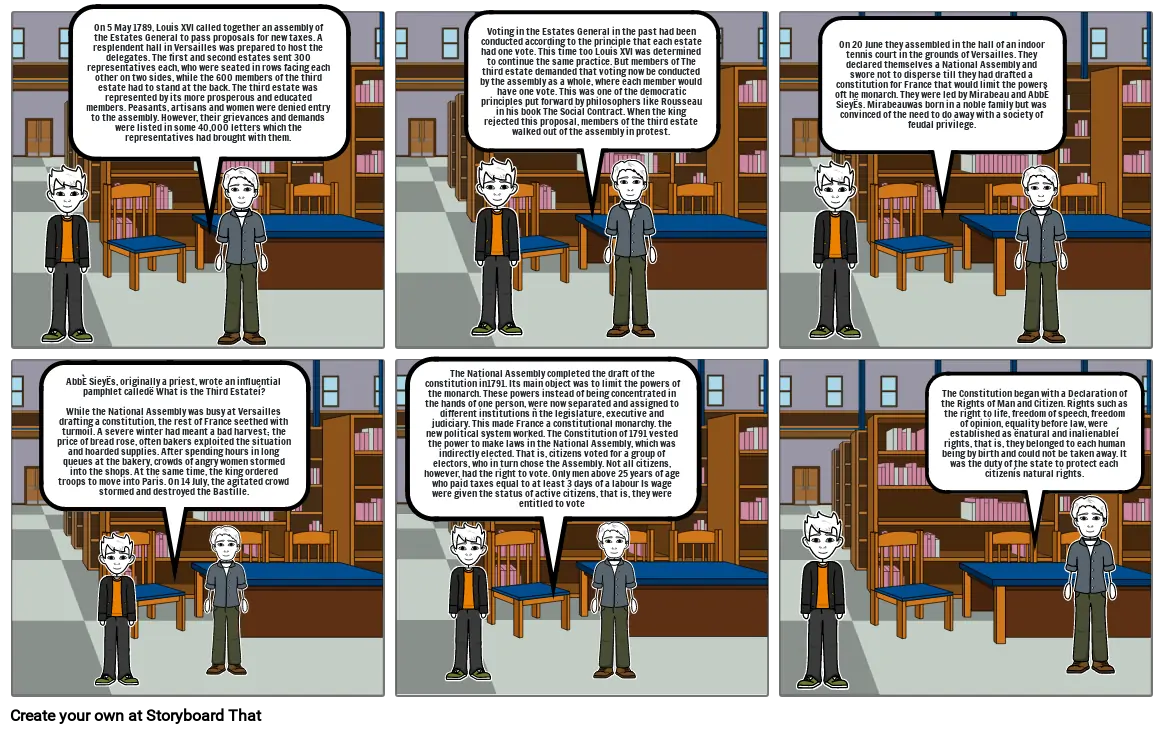Unknown Story

Storyboard Tekst
- On 5 May 1789, Louis XVI called together an assembly of the Estates General to pass proposals for new taxes. A resplendent hall in Versailles was prepared to host the delegates. The first and second estates sent 300 representatives each, who were seated in rows facing each other on two sides, while the 600 members of the third estate had to stand at the back. The third estate was represented by its more prosperous and educated members. Peasants, artisans and women were denied entry to the assembly. However, their grievances and demands were listed in some 40,000 letters which the representatives had brought with them.
- Voting in the Estates General in the past had been conducted according to the principle that each estate had one vote. This time too Louis XVI was determined to continue the same practice. But members of The third estate demanded that voting now be conducted by the assembly as a whole, where each member would have one vote. This was one of the democratic principles put forward by philosophers like Rousseau in his book The Social Contract. When the king rejected this proposal, members of the third estate walked out of the assembly in protest.
- On 20 June they assembled in the hall of an indoor tennis court in the grounds of Versailles. They declared themselves a National Assembly and swore not to disperse till they had drafted a constitution for France that would limit the powers oft he monarch. They were led by Mirabeau and AbbÈ SieyËs. Mirabeauwas born in a noble family but was convinced of the need to do away with a society of feudal privilege.
- AbbÈ SieyËs, originally a priest, wrote an influential pamphlet calledë What is the Third Estateí?While the National Assembly was busy at Versailles drafting a constitution, the rest of France seethed with turmoil. A severe winter had meant a bad harvest; the price of bread rose, often bakers exploited the situation and hoarded supplies. After spending hours in long queues at the bakery, crowds of angry women stormed into the shops. At the same time, the king ordered troops to move into Paris. On 14 July, the agitated crowd stormed and destroyed the Bastille.
- The National Assembly completed the draft of the constitution in1791. Its main object was to limit the powers of the monarch. These powers instead of being concentrated in the hands of one person, were now separated and assigned to different institutions ñ the legislature, executive and judiciary. This made France a constitutional monarchy. the new political system worked. The Constitution of 1791 vested the power to make laws in the National Assembly, which was indirectly elected. That is, citizens voted for a group of electors, who in turn chose the Assembly. Not all citizens, however, had the right to vote. Only men above 25 years of age who paid taxes equal to at least 3 days of a labour Is wage were given the status of active citizens, that is, they were entitled to vote
- The Constitution began with a Declaration of the Rights of Man and Citizen. Rights such as the right to life, freedom of speech, freedom of opinion, equality before law, were established as ënatural and inalienableí rights, that is, they belonged to each human being by birth and could not be taken away. It was the duty of the state to protect each citizenís natural rights.
Over 30 millioner storyboards opprettet

